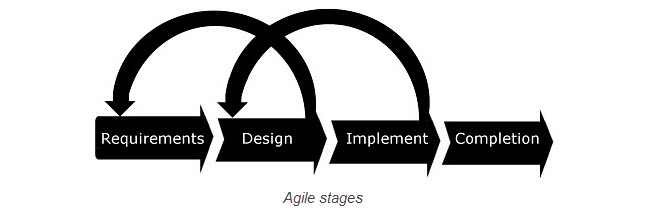![]() By Alan Cairns
By Alan Cairns
PM Hut
Put simply project managers are in the business of making things happen. Project management can concern many different types of activity or project, and project managers are in charge of executing the planning, organization, management and control of resources to make it happen.
Project management can concern all manner of projects, from building a house to writing computer software. The manager’s skill lies in curating the resources effectively to achieve the end result.
Traditional (or Waterfall) Project Management
Project managers traditionally identify a number of steps to complete a project, which typically must be completed sequentially. In traditional project management there are typically four stages:
- Requirements
- Planning & design
- Implementation
- Completion
 Not all projects will include every stage, but most projects include elements of these stages, sometimes repeatedly as one activity relies on the completion of the last. Most complicated projects require many more stages than this, which could include:
Not all projects will include every stage, but most projects include elements of these stages, sometimes repeatedly as one activity relies on the completion of the last. Most complicated projects require many more stages than this, which could include:
- Conception
- Initiation
- Analysis
- Design
- Construction
- Testing
- Production/Implementation
- Verification
- Maintenance
It’s called the waterfall method because tasks are completed sequentially like water rolling down a cliff face.
It is widely accepted that the traditional, or waterfall development model works well for small, well-design projects but can fall short in bigger, less well-defined projects that may change over time. The waterfall model originates in manufacturing and construction, where project are well-defined and after-the-fact changes are extremely costly and often impossible. It was when this model was applied to software development that its unresponsive nature became a flaw.
Agile (or Iterative) Project Management
The agile project management model, or flexible product development approach, is based on principles of human interaction management, and is most commonly used in software, website, creative and marketing industries. In this approach project managers see a project as a series of small tasks defined and completed as the project demands, in a responsive and adaptive manner, rather than as a pre-planned process.

Agile project management’s flexible and interactive characteristics are highly relevant to the industry where it was created – software development. It’s thought that this technique is best used on small projects, or projects that are too complex for a client to understand before testing prototypes. It’s also highly appropriate for teams of professionals who work together on a daily basis. It’s much less likely to be an appropriate methodology for teams that are based in geographically-disparate locations/time zones, where it probably makes more sense to implement the waterfall method.
Comparison
The traditional method of project management has been criticized for being unable to adapt to changes in projects, so a project’s success depends on an adequate initial brief. It leaves no room for testing prototypes or making design alterations based on behavior or user experience. Agile is generally considered to be much more useful in software development and many creative industries, as it allows for continual adaptation of the brief and response to client specifications.
Agile is not without its critics though; many believe that the agile model doesn’t scale well, which is why many of the biggest software development projects are still being conducted in Waterfall. While it is a useful approach to projects which are likely to have multiple changes, it is seen as offering no advantages over large projects where detailed requirements are known and changes are unusual or prohibitively expensive.
Choosing Between Waterfall & Agile Models
Choosing between models can be difficult, so if you’re struggling with this question, ask yourself the following questions;
- How stable are the requirements?
This is one of the main factors in deciding which method to use. If the requirement of a project are likely to keep changing its best to use iterative approaches such as agile, as it provides a framework in which new requirements can be accommodated once the project is underway. Using waterfall methods is like playing snakes and ladders; you can move forward but you can end up back at the start if the brief changes.
If you are working on a project where the requirements are unlikely to change, and where a number of tasks need to be completed before the project can move the next phase, waterfall is the most appropriate model.
- Are project teams working closely together?
If project teams are located far apart, coordination of work needs to be relatively detailed to avoid confusion and wasted time. In this instance Waterfall is likely to be the most appropriate method, offering clear deliverables and project milestones and dependencies. Working closely together with close communication is a key part of the agile approach, which changes and is molded each day by customer requirements. Planning gives offshore workers the ability to get on with work without having to consult a manager continually.
- What are the critical resources?
When projects require unique, specialist skills or equipment and these resources are not immediately available, good planning is required. If this is costly or difficult to organize, it’s important to ensure that the resource is fully utilised during its scheduled usage. For this Waterfall is a better approach, as each milestone must be completed before the project can proceed to the next stage. This will help to ensure that critical resources are used minimally and efficiently.
Alan Cairns is a project manager at mobilize, a company mainly specializing in mobile forms.



